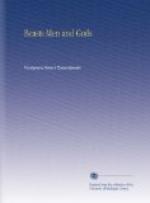When our party left Uliassutai, we traveled on leisurely, making thirty-five to fifty miles a day until we were within sixty miles of Zain Shabi, where I took leave of the others to go south to this place in order to keep my engagement with Colonel Kazagrandi. The sun had just risen as my single Mongol guide and I without any pack animals began to ascend the low, timbered ridges, from the top of which I caught the last glimpses of my companions disappearing down the valley. I had no idea then of the many and almost fatal dangers which I should have to pass through during this trip by myself, which was destined to prove much longer than I had anticipated. As we were crossing a small river with sandy shores, my Mongol guide told me how the Mongolians came there during the summer to wash gold, in spite of the prohibitions of the Lamas. The manner of working the placer was very primitive but the results testified clearly to the richness of these sands. The Mongol lies flat on the ground, brushes the sand aside with a feather and keeps blowing into the little excavation so formed. From time to time he wets his finger and picks up on it a small bit of grain gold or a diminutive nugget and drops these into a little bag hanging under his chin. In such manner this primitive dredge wins about a quarter of an ounce or five dollars’ worth of the yellow metal per day.
I determined to make the whole distance to Zain Shabi in a single day. At the ourtons I hurried them through the catching and saddling of the horses as fast as I could. At one of these stations about twenty-five miles from the monastery the Mongols gave me a wild horse, a big, strong white stallion. Just as I was about to mount him and had already touched my foot to the stirrup, he jumped and kicked me right on the leg which had been wounded in the Ma-chu fight. The leg soon began to swell and ache. At sunset I made out the first Russian and Chinese buildings and later the monastery at Zain. We dropped into the valley of a small stream which flowed along a mountain on whose peak were set white rocks forming the words of a Tibetan prayer. At the bottom of this mountain was a cemetery for the Lamas, that is, piles of bones and a pack of dogs. At last the monastery lay right below us, a common square surrounded with wooden fences. In the middle rose a large temple quite different from all those of western Mongolia, not in the Chinese but in the Tibetan style of architecture, a white building with perpendicular walls and regular rows of windows in black frames, with a roof of black tiles and with a most unusual damp course laid between the stone walls and the roof timbers and made of bundles of twigs from a Tibetan tree which never rots. Another small quadrangle lay a little to the east and contained Russian buildings connected with the monastery by telephone.
“That is the house of the Living God of Zain,” the Mongol explained, pointing to this smaller quadrangle. “He likes Russian customs and manners.”




